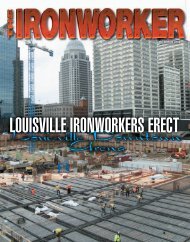2012 Iron Workers/IMPACT North American Labor-Management ...
2012 Iron Workers/IMPACT North American Labor-Management ...
2012 Iron Workers/IMPACT North American Labor-Management ...
You also want an ePaper? Increase the reach of your titles
YUMPU automatically turns print PDFs into web optimized ePapers that Google loves.
Thoughts from an Old Timer: Hand Line Work<br />
It was the mid-1960s and me and<br />
another young guy were sent out<br />
on a job by Local 361 Business Manager<br />
Paul S. (Whitey) Rockhold from<br />
the hall in downtown Brooklyn, N.Y.<br />
We were both permit men and although<br />
there were quite a few book<br />
men in the hall that morning, no one<br />
beefed about our getting the job. The<br />
company was named Issacson Steel<br />
Erectors, and the job was in Queens<br />
Borough on Bell Boulevard. The other<br />
man had a car and we drove out to<br />
Queens and found the job easily. The<br />
crane was sitting there on the street<br />
waiting for the 8 a.m. start time.<br />
The job was an apartment building<br />
already up two stories with the<br />
floor already formed and poured and<br />
the masonry walls up (pre-decking).<br />
We started work just about immediately<br />
and placed the rig and started<br />
setting up. There were no hydraulics<br />
and we pulled out the outriggers<br />
manually and screwed down the pans<br />
same way, while the operator swung<br />
the rig left and right trying to help us<br />
level up. Once we set up, we brought<br />
the first of two steel trucks (one floor<br />
of iron) in and started unloading. The<br />
pusher Nick Caputo told us to keep<br />
the loads light so he could distribute<br />
them further around the floor. We unloaded<br />
both steel trucks and then a<br />
company truck with bolts and some<br />
gear I’d never seen before, not that I’d<br />
seen too much before. I was excited<br />
to get started setting steel because<br />
I’d heard so much about “connecting.”<br />
But then a curious thing happened.<br />
The gang came down off the building<br />
and we broke the rig down and it left<br />
the job. We had coffee and went back<br />
up on the building. We started shaking<br />
out by putting the heavier pieces<br />
on a two wheeled dolly and pushing<br />
the pieces around the floor and taking<br />
them off close to where they were<br />
to be set. The “smaller” pieces, me<br />
and my partner walked around the<br />
floor putting them home. Nick didn’t<br />
want to overwork the dolly. Once all<br />
the shaking out was done, we started<br />
setting. For the headers, we used<br />
a primitive heavy (was there anything<br />
other than heavy?) contraption<br />
known as a Dutchman, which was<br />
the forerunner of a manufactured<br />
roustabout.<br />
The two story columns were set<br />
with one man, manning the splice<br />
plates at the base and the rest of<br />
us tripping the columns upright.<br />
The other man, whose name I remember<br />
in the gang was the shop<br />
steward Alonzo (Lonzo) Laite. He<br />
was the strongest man I ever knew<br />
and among the nicest. He also had a<br />
busted larynx from a job injury and<br />
was an officer of the local (I loved<br />
Lonzo - he’s gone now). It seemed<br />
the more I tried; I was always in<br />
the wrong place and moving in the<br />
wrong direction. Every time I collided<br />
with a piece of steel, the gang<br />
hooted and hollered delightedly at<br />
my expense. The other young fella<br />
was doing about the same as me. By<br />
the end of the day, we were a mass<br />
of lumps and bumps and bruises and<br />
our clothes were torn. I thought for<br />
sure we were going to be fired, but<br />
all Nick said was see you tomorrow.<br />
The next day, we set the few remaining<br />
pieces and the gang left me<br />
and the other young guy to bolt everything<br />
up. They were all 3/4 common<br />
bolts with lock washers. About 1<br />
p.m., the company truck driver came<br />
and we loaded up the Dutchman<br />
and dolly on the truck and he told<br />
the other guy to go to a Chinatown<br />
address in Manhattan. I was left to<br />
finish the bolting up, but the driver<br />
told me to go to the same place in<br />
Chinatown next day.<br />
When I showed up for work the<br />
next day, the gang asked me where<br />
the other guy was? I didn’t know and<br />
never saw that man again. We worked<br />
all over the city and sometimes moved<br />
to other jobs during the day, taking comealongs,<br />
blocknfalls, and our personal<br />
tools right on busses and subways<br />
to the next job. I was able to stay with<br />
that company for quite awhile, eight<br />
months or so and finally, they ran low<br />
on work and I got paid off.<br />
Although I was to go on to connect<br />
steel for some twenty years around<br />
NYC, I always remembered that hand<br />
line work and how it taught me to use<br />
my body as a tool and to move as one<br />
with other men while setting steel by<br />
hand. A lost art I think.<br />
Respectfully Submitted<br />
J. Thomas Dilberger<br />
Local 361 (Brooklyn, N.Y.)<br />
J.I.W. 873894 (Ret.)<br />
14 THE IRONWORKER




